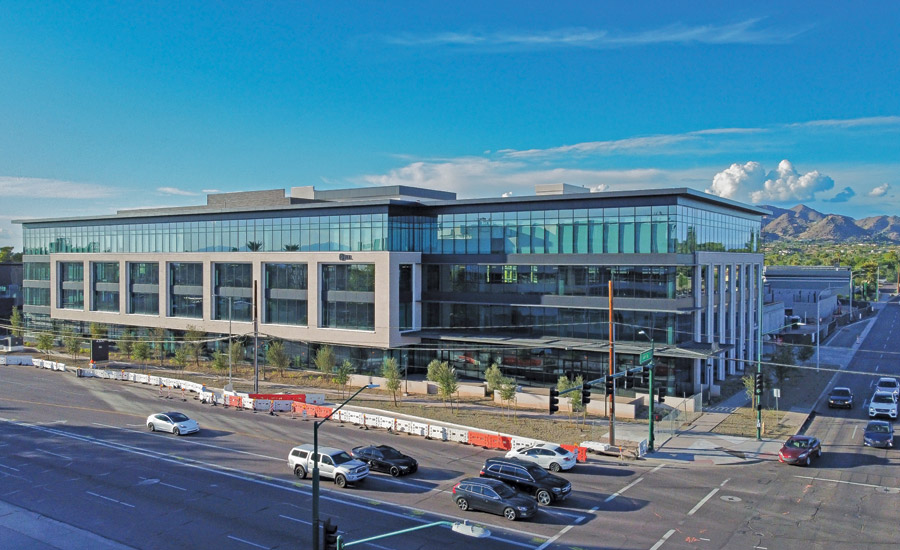With 2023 moving along quickly, Tempe, Ariz.-based Okland Construction eyes completion by year’s end of the Grove, the sprawling, multi-phased mixed-use complex taking final shape in the historic Arcadia community of Phoenix. The Okland-led team building the $400-million, 750,000-sq-ft project—which includes seven buildings of office and medical space, a sports training facility, residential above a parking garage, retail and restaurants—has endured all of the pandemic-era challenges of material and price disruptions, and then some, since the bulk of construction started in 2021.
RED Development, Phoenix, is the master developer, with Mesa, Ariz.-based WoodPatel providing master planning, civil engineering construction documents and construction management. The Grove’s first building to open, dating back to September 2020, was the 53,000-sq-ft Phoenix Suns/Phoenix Mercury pro-sports training facility, built by the Phoenix office of AECOM Hunt Construction Group.

Workers prepare the rooftop restaurant area of the Global Ambassador hotel at the Grove.
Photo courtesy Okland Construction
Several months later, in early 2021, a subcontractor working for Okland demolished the rest of the 13-acre block, and excavation and grading work followed shortly thereafter to make way for the campus’ 1,000-space parking garage, which comprises four-and-a-half levels, including three below ground.
At the same time, Okland began construction of the 180,000-sq-ft 4300 Office Building on the north side of Camelback Road at 44th Street. Two Scottsdale, Ariz., firms provided design of the four-level building: architectural firm Nelsen Partners and Testani Design Troupe, which designed the interiors and rooftop amenity deck.
The first tenant, JLL, the brokerage firm that represented RED in leasing the building, moved in last October. The building has been WELL certified as a healthy space, and JLL is expected to receive LEED Silver certification for its office by April.
“The building was 100% leased prior to completion, and RED garnered record-breaking price-per-square-foot rates, setting a new standard for Class AA office rents in the state, with all leases executed during the global pandemic,” says Mike Ebert, RED managing partner.

A crew from Suntec Concrete, an Okland trade partner, flies table formwork into place at the Global Ambassador hotel.
Photo courtesy Okland Construction
Another piece of the Grove complex that was completed in December was the Life Storage Building. Princeton Construction led the 114,000-sq-ft, three-story building, designed by Robert Brown Architects, Chandler, Ariz..
Another component of the Grove just opened in February: the 70,000-sq-ft Medical Office Building, anchored by Banner Healthcare. RED and Okland Construction contracted with Nelsen Partners to design the core/shell, including the facade, landscaping, hardscape elevators and key utility rooms. Banner contracted with Devenney Group Architects Ltd., Phoenix, to design the tenant improvements, which included the imaging and orthopedic suites, urgent care and women’s health.
Set to complete in July is the 54-unit Bergen apartment building, developed by StreetLights Residential, Texas. Okland and Nelsen are again working together on this building, which is located above the parking garage.

The 4300 Office Building is adjacent to the marquee entry to the Grove campus from Camelback Road.
Photo courtesy RED Development
And scheduled to open in the third quarter is the Global Ambassador, a 141-room luxury hotel developed by restaurateur Sam Fox with Phoenix-based Common Bond Development. The 200,000-sq-ft venue will include an 18,000-sq-ft rooftop restaurant. Okland, Nelsen and Testani are again collaborating on the project, with Scottsdale’s Berghoff Design Group providing the landscape architecture services.
Nelsen coordinated with the various owners and the design/construction team to ensure that “the project felt like a campus without monotonous uniformity,” says George A. Melara, the firm’s vice president and managing director. “We knew that this was a significant site with a great mix of uses. The key for us was to listen carefully to the various stakeholders and provide solutions that unify the development.
“The process was iterative and comprehensive, orchestrating a little give and take and borrowing of ideas to come up with a unique solution,” he adds. “There is a bent toward contemporary, clean and sophisticated, with definite European influences that are reinterpreted for our environment.”
Melara relied on site design, lighting, materials and landscaping to create this cohesiveness. “The palette of materials is definitely something that we were very conscious of,” he says. “The use of a lighter color palette of masonry was something that we all gravitated to as an appropriate response to the site, scale and vibe that we felt was appropriate for Arcadia.”
“One GC’s parking lot was another GC’s laydown yard. Both were working toward deadlines and needed the space at the same time.”
—Carlos Gonzalez, Okland Project Director
In addition to the other general contractors, Okland has had five company teams working on site, often simultaneously. The site development group demolished the disused banks, restaurants and doctors’ offices and prepared for the new structures. A second team built the parking garage, a third the office building and another the medical offices. A fifth team is building the hotel.
“Some of the players mingled in and out of various teams, but each group was tasked with a specific project,” says Carlos Gonzalez, Okland’s project director for the development excluding the hotel. Wayne Oxberger is the general superintendent for site development, the parking garage and the 4300 Office Building; JJ Bitner, a project superintendent, focuses on final finished products; and Joseph Ellis, senior superintendent, is responsible for safety and scheduling and the hotel project.
Once Princeton Construction and StreetLights Residential started on site, Okland scheduled Thursday general contractor meetings to focus on goals for the next week. “As we were completing the office building, we faced new coordination challenges with the tenant-improvement GCs that were added to the mix,” Gonzalez explains.

The 4300 Office Building is topped by an amenity deck with views of landmark Camelback Mountain.
Image courtesy RED Development
This teamwork has been important to completing infrastructure on an active site: roads, parking lots and utilities. “One GC’s parking lot was another GC’s laydown yard. Both were working toward deadlines and needed the space at the same time,” he says.
“The site is very urban, and fitting all the utilities, signage, lighting and transformers was a challenge to coordinate,” says Nelsen’s Melara. Labor was an issue early on. In 2020, Okland teams on other projects experienced shortages as carpenters and finishers had to quarantine, Gonzalez says. During the first half of 2021, as the company began work on the Grove, its scope included demolition, grading and building shoring walls, which required just a few well-staffed trade partners, he says. “By the time we started building foundations that summer, it seemed that the trades had regained their footing after the 2020 COVID shock.”
“We knew we had to either pour today or pour in two weeks.”
—JJ Bittner, Project Superintendent, Okland Construction
Most materials were available by 2021; the team knew that ordering early was essential. In 2020, “we had ordered materials but just had to wait,” Gonzalez says. For the 4300 Office Building and the hotel, Judith Testani, founder of Testani Design Troupe, and her interior design team were challenged by price hikes, availability issues and delays. “We’ve been diligent about finding products that are available and have worked with the team to get things ordered well in advance of our installation dates,” she says.
Concrete and grout availability was another matter. For the Life Storage building, Princeton Construction had to innovate to find grout for the CMU walls, says Sean Sullivan, director of commercial construction. “Our subcontractors regularly checked the lead time on deliveries from batch plants and would work deals with other subcontractors to get material,” he says.
By mid-2021, portland cement and fly-ash shortages were impacting allocations, deliveries and workflow. Concrete placements that would typically take a day had to be divided into multiple pours, impacting the labor and equipment costs and timing.
“These allocations brought unprecedented schedule uncertainty,” Gonzalez says. “During the height of COVID-19, we never experienced such availability whiplash from day-to-day concrete availability.”
Bittner adds that, typically, a team often has day-to-day flexibility when scheduling concrete placements. With the tight availability, however, “We knew we had to either pour today or pour in two weeks.”
Additionally, the Grove is in the luxury residential area of Arcadia, which is fairly distant from the batch plants, making the time-sensitive truck shelf life of concrete even more critical. A shortage of delivery trucks and drivers later intensified the concrete issues.
The team responded in various ways.

The Global Ambassador Hotel will feature restaurants developed by noted restaurateur Sam Fox.
Image courtesy RED Development
“Sometimes we would receive notice that concrete was not available just hours before we were expected to start pouring,” Gonzalez says. “Or we would hear, ‘You can have a 1,000 yards on this day at this time.’ And often we would coordinate with our own projects on the other side of town. We thought, ‘Let’s get that concrete over here to our site so that we can keep this going to meet our deadline.’”
He adds: “Sometimes, we scrambled to find concrete finishers because we received notice that another project failed an inspection and concrete was available to the first project that could take that allocation.”
The team also committed more Saturday hours to adjust and remain on the overall project schedule. “We lost sleep but not time,” says Bittner, the project superintendent.
“This situation was foreign to me even after 20-plus years in the business,” Gonzalez says, “and I credit our concrete trade partners for maintaining a high level of concrete-finish quality despite these challenges.”



Post a comment to this article
Report Abusive Comment